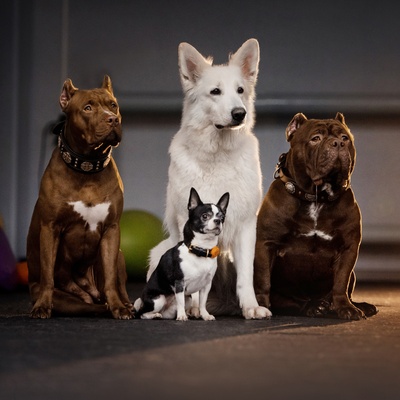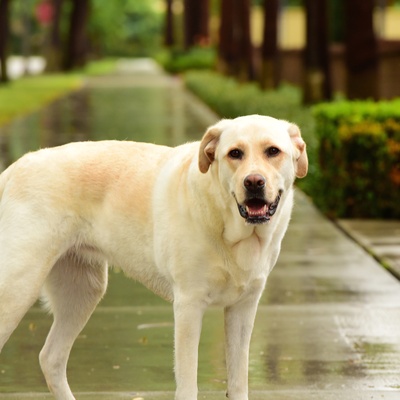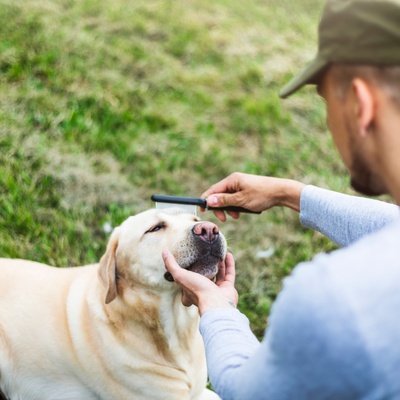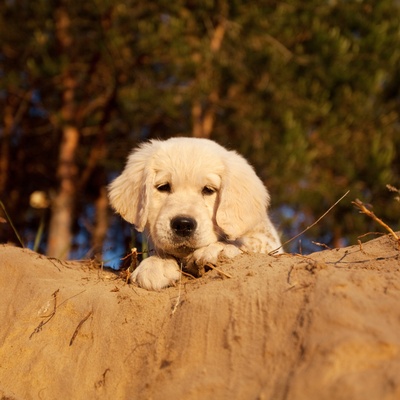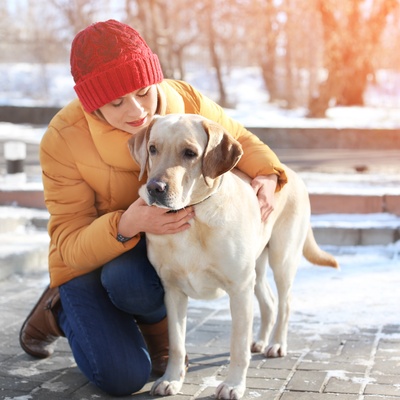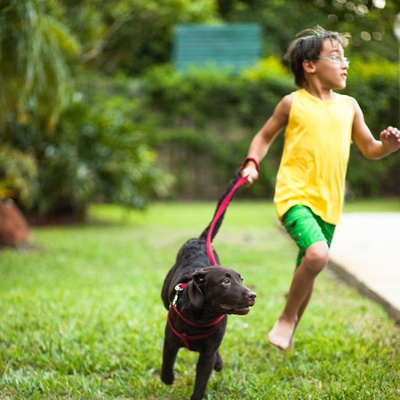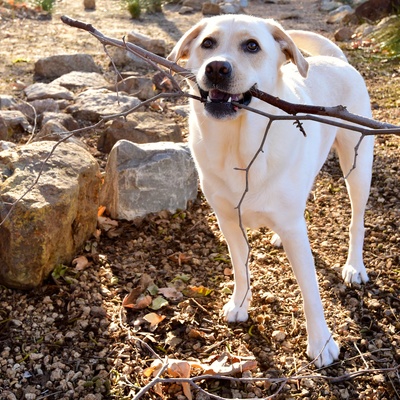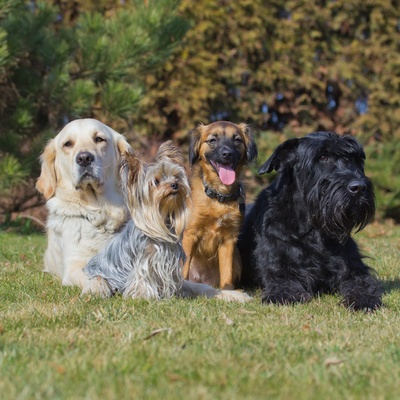Introducing the Labrador Retriever
Discover all there is to know about the Labrador Retriever: its characteristics, behaviour, training, and how much one costs.
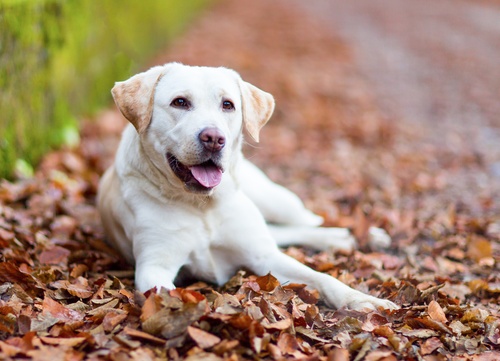
Discover all there is to know about the Labrador Retriever: its characteristics, behaviour, training, and how much one costs.
Initially bred to help fishermen haul nets and catch escaping fish, this breed has transcended its utilitarian roots to become one of the most cherished breeds in Great Britain and beyond. The Labrador is the epitome of versatility, excelling as a guide dog, in search-and-rescue, and in therapeutic settings, not to mention its unwavering status as a beloved family member.
These dogs are renowned for their loyal nature, demonstrating affection and a gentle disposition that endears them to young and old alike. With their high sociability and fondness for human company, Labradors are not just pets; they're devoted companions, infusing homes with joy and unmatched loyalty.
This section outlines the unique features of the Labrador Retriever breed of dog.
The Labrador Retriever, part of the sporting group (group 8), is known for its intelligence, active temperament, and strong instincts in water and woods.
Labradors are considered large dogs, with a height range typically between 21.5 to 24.5 inches at the shoulder and a weight span of about 55 to 80 pounds.
Labradors boast a short, dense, weather-resistant coat. This double-layered fur provides insulation and water resistance during their aquatic adventures.
While the breed's coat comes in a variety of shades, the Labrador is primarily known for three main colors: black, yellow, and chocolate, with variations within these hues.
The adaptable Labrador Retriever thrives in various settings but does best with space to roam and play, making a house with a yard an ideal environment.
Known for their friendly and outgoing nature, Labradors are excellent with children and other animals, making them ideal family pets.
Generally robust, Labradors are nonetheless prone to certain breed-specific conditions like hip and elbow dysplasia and should be screened regularly for health concerns.
Labradors are eager to please and quick to learn, making them highly trainable with a positive reinforcement approach that rewards their good behavior.
We can help!
Every dog has its own character, and so do you. Making the right choice will ensure his well-being and yours.
Take our quiz to find out which breed is right for you, based on your personality, lifestyle, location and many other criteria.
Don't wait any longer and take the quiz to find out the answer!
The Labrador Retriever has a strong build, broad head, and water-resistant coat ideal for its origins as a fisherman's companion.
Labradors are medium, robust dogs with females standing at about 21.5 to 23.5 inches and males a tad taller at 22.5 to 24.5 inches at the withers. Weight-wise, females tip the scales at approximately 55 to 70 pounds, while males are heftier at around 65 to 80 pounds.
Labradors are known for their rapid growth during the puppy phase, often reaching half their adult weight by six months of age. By the age of one, most Labradors will have reached their full height, with weight continuing to fill out until they're about two years old.
The Labrador Retriever sports a short, dense coat that is designed for the outdoors. This breed has a distinct double-layered coat with a soft undercoat for insulation and a straight, weather-resistant outer coat.
While not long, the Labrador's fur is highly efficient for an active lifestyle, providing protection in water and buffering against cold weather conditions.
The coat of the Labrador Retriever is typically seen in three standard colors: chocolate, black, and yellow. While these are the most recognized shades, variations can occur within each color range, such as fox-red in yellow Labradors or silver in chocolate and black Labradors.
Labradors are equipped with a coat that serves them well in various climates, thanks to its length and the thick undercoat. They do shed throughout the year, with seasonal peaks in the spring and fall when they blow their coats.
Regular brushing, ideally a couple of times a week, is essential to manage shedding and keep their coat healthy. Baths can be given occasionally, as Labradors have a natural oil in their coat that helps with water resistance. Frequent bathing can strip this oil, so it's best to bathe a Labrador only when necessary.
The Labrador Retriever is the embodiment of balance and proportion. With a sturdy and athletic frame, they present a well-structured head boasting a broad skull and pronounced stop. The breed's expressive eyes, often a warm brown, convey intelligence and good nature.
Their medium-sized ears hang close to the head, neither too high nor too low. The Labrador's body showcases a strong, muscular build, with a wide chest and a level top line leading to a thick, powerful tail that tapers at the end – an essential rudder for their love of swimming.
The Labrador Retriever is celebrated for its friendly and outgoing nature, displaying an exceptional balance of loyalty, gentleness, and affection in its role as a companion.
With over 400 recognized breeds classified into 10 distinct groups, the canine world is diverse. The Labrador Retriever finds its place in Group 8, encompassing retrievers, flushing dogs, and water dogs. This group is home to breeds such as the Spaniel, the Portuguese Water Dog, and of course, the Labrador itself.
Breeds within this group are known for their diligence in the field and natural instinct for retrieval, combined with their remarkable intelligence and accommodating temperament.
Labradors, in particular, excel as both family pets and versatile working dogs, adept in various roles from aiding the disabled to active fieldwork, all thanks to their trainable nature and innate desire to please.
Labradors are renowned for their even-tempered and affectionate nature, often described as friendly, outgoing, and high-spirited. These dogs form strong bonds with their owners, showing an abundance of affection that is only matched by their need for human companionship.
The presence of an attentive owner is crucial for the emotional well-being of a Labrador, as they thrive on interaction and engagement.
Embodying sociability and kindness, Labradors are well-known for their good nature with humans and other animals alike. They are not just pets but integral members of the family, often being excellent companions for children due to their patience and playful spirit.
Although naturally sociable, it is important to introduce Labradors to various social situations early in life to reinforce their innate friendly disposition.
Labradors are remarkably adaptable, thriving in various living conditions from apartments to sprawling country homes. However, regardless of their habitat, they require a devoted owner's attention and time.
Daily walks are essential, with a recommended total of at least one hour of exercise to keep them physically and mentally stimulated.
While Labradors can adjust to different home environments, they have a natural affinity for the outdoors. A secure backyard or frequent visits to the park are ideal for these curious canines to explore and play.
Their love for activity and inherent retrieving instincts make them happiest when they have space to move, play fetch, and, if possible, splash around in water.
The Labrador Retriever is a testament to trainable intelligence, known for its keen ability to learn commands and interpret cues swiftly. This breed responds exceptionally well to positive reinforcement and consistency in training. Given their adventurous spirit, outfitting a Labrador with a GPS collar is a wise measure to ensure their safety during outdoor activities and prevent any unexpected wanderings.
Labradors possess a remarkable willingness to listen and learn, making them one of the top choices for various roles, including service and therapy dogs. Unique to their training is their innate desire to please their owners, which when harnessed with an understanding and patient approach, can lead to excellent results in obedience and task-oriented training.
Take the test and find out the dog breed that matches your personality and lifestyle.
The Labrador Retriever is generally known for its robust health, but like all breeds, they require consistent daily care to prevent common illnesses and maintain their well-being.
Labradors are typically a sturdy breed, often enjoying good overall health. However, they are predisposed to certain conditions such as hip and elbow dysplasia, heart disorders, and hereditary eye problems.
Symptoms can vary, ranging from mobility issues to more acute medical conditions. With proper care and regular veterinary check-ups, many Labradors live full lives, typically ranging from 10 to 12 years.
Regular veterinary visits for vaccinations, parasite control, and health screenings are critical to a Labrador's health.
Daily care routines should include coat brushing, ear cleaning to prevent infections (especially for those that enjoy swimming), dental hygiene to prevent periodontal disease, and nail trimming to prevent overgrowth and splitting.
It's important to be vigilant for signs of allergies in Labradors, consulting with a vet for management plans. Labradors are not classified as hypoallergenic and can shed quite a bit.
Each Labrador Retriever has its unique dietary needs, but all require a balanced diet to sustain their energy and health. Proteins and vitamins are crucial in a Labrador's diet to support their muscular build and active lifestyle.
Premium kibble formulated for large breeds can provide a well-rounded base for their nutritional needs. For those Labradors with higher activity levels, supplementing with lean proteins from white and red meats can be beneficial, though it's vital to monitor fat intake to maintain a healthy weight.
The Labrador Retriever is highly esteemed worldwide, and in Great Britain, it's one of the favoured breeds. There are numerous breeders available, but it's important to consider several factors before adopting.
Selecting a Labrador Retriever is a process that necessitates careful consideration and informed decisions. Ensuring you choose a reputable breeder is paramount. It is advisable to visit the breeding facility before adoption to observe the living conditions and behavior of the dogs. Health is paramount, so inquire about the puppy's health, its parents, and any hereditary conditions.
Lastly, you must have your dog microchipped by the age of 8 weeks old and have their details registered on a relevant database like Petlog or Animal Tracker. This is a legal requirement in Great Britain, with non-compliance potentially resulting in a £500 fine. Microchipping can be done by your vet for a fee or by any Blue Cross center for free.
The initial cost of a Labrador Retriever can fluctuate based on factors such as the breeder's reputation, the dog's lineage and pedigree, and the age at the time of purchase. Prices for a Labrador puppy may range from approximately
to
.
The financial commitment extends beyond the purchase, with annual expenses for health care, nutrition, and other needs averaging around
to
.
Choosing a dog that matches your personality and lifestyle will ensure your well-being and his!
To access the most relevant information, suitable payment methods, and delivery in your region, please select the website corresponding to your country.

